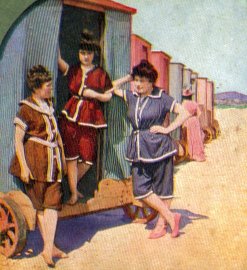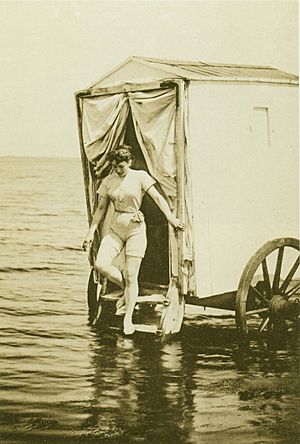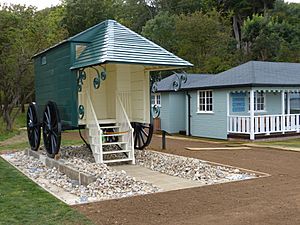Bathing machine facts for kids
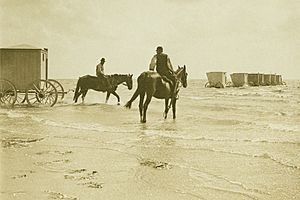
A bathing machine was a special wooden cart used at beaches a long time ago, from the 1700s to the early 1900s. Its main job was to help people change into their swimming clothes and get into the ocean without being seen. These carts had roofs and walls, and they could roll right into the sea. Some had solid wooden walls, while others used canvas over a wooden frame. They usually had doors at both ends or curtains for privacy.
Back then, it was very important for people, especially in Britain, to be modest and private when swimming. Bathing machines helped people follow these social rules. Even with the machines, men and women often swam in separate areas. This was to make sure people of different sexes didn't see each other in their swimsuits. Even though these swimsuits covered a lot more than modern ones, they were still not considered proper public clothing.
Contents
How People Used Bathing Machines
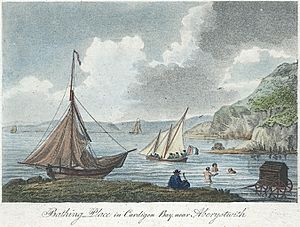
People would get inside the small room of the bathing machine while it was still on the beach. They would be wearing their regular clothes. Once inside, they would change into their swimwear.
These machines usually had small windows. However, one writer in 1906 thought they were "ill-lighted," meaning they didn't let in much light. They wondered why the machines weren't made better with a skylight (a window in the roof).
Moving the Machines into the Water
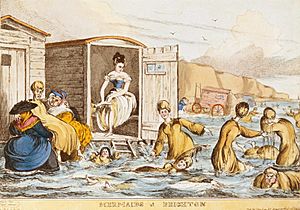
Most bathing machines had large, wide wheels. Horses, or sometimes a pair of horses, would pull them into the water and back out. A driver would guide the horses. Less often, people would push the machines into the water themselves. Some beaches even had wooden tracks or rails built into the water for the wheels to roll on. A few places used steam engines and cables to pull the machines in and out of the sea.
Once the machine was in the water, the person inside would step out from the side facing the sea. They would walk down steps into the water. Many machines had doors at both the front and back. If a machine only had one door, it would be backed into the sea or turned around. It was very important that the machine blocked any view of the swimmer from the shore. Some machines even had a canvas tent that could be lowered from the seaside door. This tent could reach the water, giving the swimmer even more privacy.
Help from a Dipper
Some resorts had a special helper called a dipper. This was a strong person of the same sex as the swimmer. The dipper would help the swimmer get into and out of the sea. Some dippers were known for gently pushing bathers into the water, then pulling them out. This was sometimes seen as part of the fun experience!
Bathing machines often had a small flag. Swimmers could raise this flag to signal to the driver that they were ready to come back to shore.
The History of Bathing Machines
Some people say the bathing machine was first invented in 1750 in Margate, Kent, England. A Quaker named Benjamin Beale is often given credit for inventing them. People described his machines as simple but very useful. They said the "umbrella" (likely the canvas tent) allowed people to bathe very privately.
However, there's an older drawing from 1736 in Scarborough that shows people bathing. Many believe this might be the first sign of bathing machines. The county of Devon even claims they were used there a year earlier, in 1735.
Where They Were Used
Bathing machines were most common in the United Kingdom and places that were part of the British Empire. But they were also used in other countries like France, Germany, the Netherlands, Belgium, the United States, and Mexico.
Queen Victoria's Bathing Machine
Even royalty used bathing machines! Prince Albert and Queen Victoria both used one at Osborne Beach on the Isle of Wight. Queen Victoria used hers for sketching and bathing. She even wrote about using it in her diary in July 1847.
Queen Victoria's bathing machine was quite fancy. It had a front porch and curtains to hide her until she was in the water. Inside, it had a changing room and even a working WC (toilet). After she passed away, her machine was used as a chicken coop for a while. But it was restored in the 1950s and put on display in 2012.
Their Decline
Bathing machines were actively used on English beaches until the 1890s. After that, they started to be parked on the beach more often. In Britain, the rules that separated bathing areas for men and women ended in 1901. After this, the use of bathing machines quickly went down. They were then used as stationary changing rooms for several years.
Most bathing machines had disappeared from the United Kingdom by 1914. By the early 1920s, they were almost completely gone, even on beaches where older people went. However, in Aldeburgh, Suffolk, some bathing machines on wheels were still being used as late as 1938. In many places around the world today, you can still see them as stationary bathing boxes.
|
See also
- Beach hut
- Victorian morality


